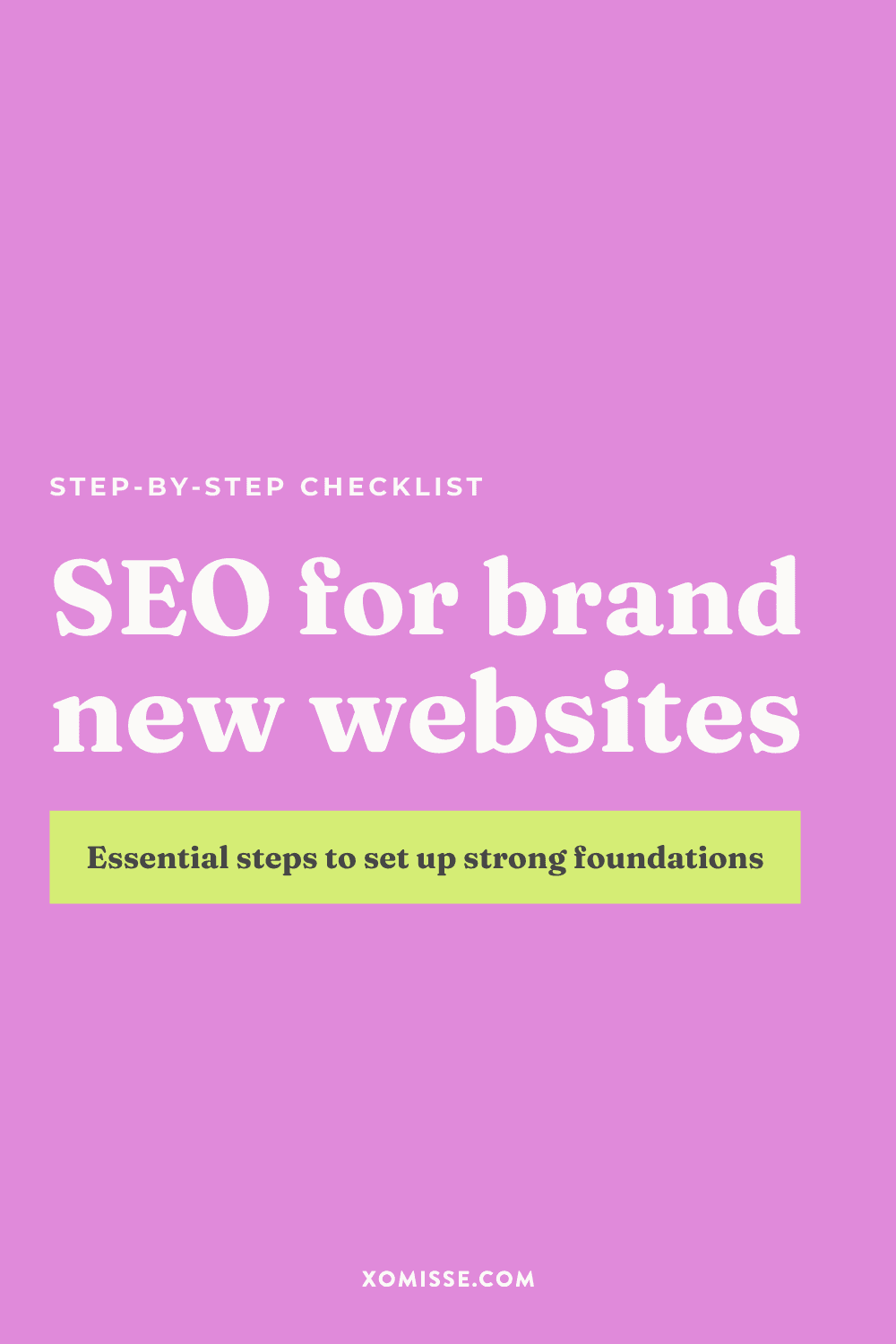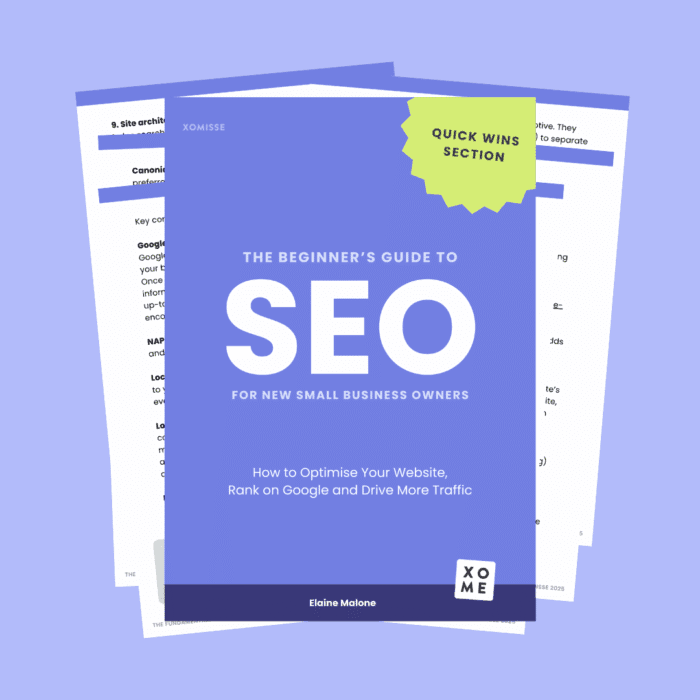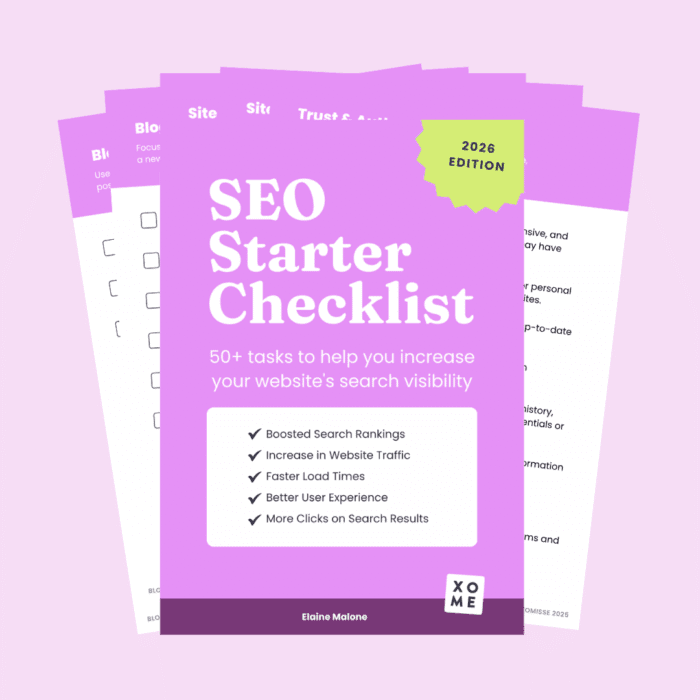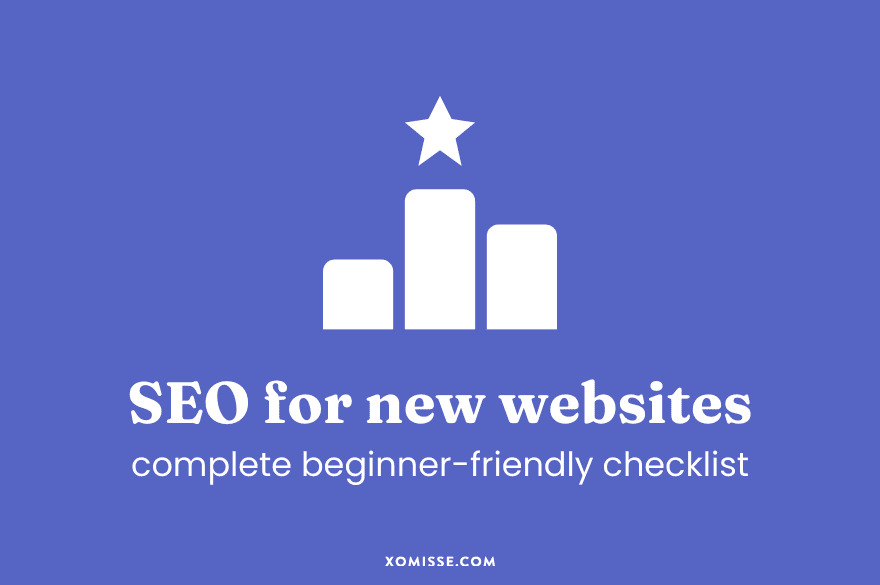Launching a new website is exciting but it can also feel overwhelming. Between writing content, choosing a design and setting everything up, SEO often gets pushed to the bottom of the list.
But here’s the truth: if your website isn’t optimised from the start, you’re missing opportunities to get found by the right people. SEO doesn’t need to be complicated or time-consuming. With the right steps, you can set up strong foundations that help your site grow for years to come.
👉 Before you dive into SEO, make sure your website is set up for success. Check out our website launch plan for a step-by-step guide to get your site live, optimised and ready to attract visitors.
SEO checklist for new websites
This checklist will guide you through the essentials of SEO for a new website (beyond just blogging) so you can feel confident your site is ready to attract visitors and convert them into clients or customers.

1. Build your website’s SEO foundations
Before diving into content, make sure your website has a strong technical foundation. Without these basics, your hard work creating pages and blog posts won’t get the visibility it deserves.
- Mobile-friendly design – Most users browse on mobile, and Google uses mobile-first indexing. That means your site is judged by its mobile version first. Test your site on different devices to make sure it’s easy to use.
- SSL certificate (HTTPS) – A secure site builds trust with visitors and is also a ranking factor. Look for the little padlock in the browser bar. If it’s missing, your site could look unsafe to visitors.
- Fast loading speed – Slow sites frustrate users and lower your rankings. Compress images, remove unnecessary plugins, and test your site using. For WordPress, here are 8 ways to speed up your website.
- Sitemap setup – A sitemap is like a roadmap for search engines. Create and submit an XML sitemap via your SEO plugin and Google Search Console so Google knows exactly what pages to crawl and index.
Think of this step as making sure your “house” is structurally sound before inviting people over.
2. Optimise your homepage to attract the right visitors
Your homepage is often the first impression for both users and search engines. It should clearly explain what you do, who you serve, and how people can take the next step.
- Clear page title – Use a descriptive format like [Business Name] | [Service/Offer] for [Audience/Location]. This helps you show up in relevant searches.
- Compelling meta description – A short summary (155–160 characters) that appears in Google results. Include your main keyword and make it inviting — this is your chance to earn a click.
- Strong H1 headline – Clearly state what you do and who you help, e.g. “Affordable graphic design for small business owners in London.“
- Introductory copy – Write 2–3 sentences that explain your core offer and what makes you different.
- Internal links – Add 2–3 links pointing to key pages (services, shop, or contact). This helps visitors navigate and signals importance to search engines.
Your homepage is your strongest SEO opportunity, inviting people into your world and promoting exactly what you have to offer.

Free SEO Guide for Beginners
Learn the key pillars of SEO and start improving your website traffic today.
3. Turn service and product pages into traffic drivers
SEO isn’t just for blog posts. Your services and products deserve to rank too. After all, they’re what you want people to buy or book.
- Keyword-focused headings – Use clear H2s/H3s with relevant phrases like “Graphic design packages for small businesses” instead of just “Services.”
- Unique content – Avoid copy-pasting the same descriptions across pages. Each product or service should have its own optimised copy.
- Compelling call-to-action (CTA) – Guide visitors to the next step with buttons like “Book your consultation” or “Shop now.“
- Structured layout – Use short paragraphs, bullet points, and visuals so visitors can scan quickly.
Treat these pages like mini landing pages: persuasive, clear, and keyword-friendly.
4. Technical SEO essentials to get found faster
A little technical setup goes a long way in making sure your website is discoverable.
- Install an SEO plugin – Tools like Yoast or Rank Math make it simple to configure metadata, sitemaps, and breadcrumbs without coding.
- Connect Google Analytics – Track where visitors come from, what they do on your site, and what’s converting.
- Set up Google Search Console – Submit your sitemap, monitor indexing issues, and find out which keywords your site is showing up for.
These tools give you the data to understand what’s working.
5. Create content that boosts visibility and builds trust
Despite what the internet tries to tell us, blogging isn’t dead. It’s still one of the most effective ways to attract organic traffic and show expertise.
- Optimise each post – Use your target keyword in the title, intro, and 1–2 subheadings.
- Add alt text to images – Describe images in a way that makes sense to both users and search engines.
- Link strategically – Add links to related blog posts and services to keep people on your site longer.
- Write for humans first – Aim to answer your audience’s questions. Search engines reward content that provides real value.
Each blog post is a new opportunity to rank on Google and bring more potential customers to your site.
The SEO Starter Checklist
50+ easy steps to rank on Google, increase website traffic and boost your visibility as a new business

6. Strengthen trust and local visibility
Google values sites that look credible and user-friendly. Trust signals reassure both search engines and visitors.
- Dedicated contact page – Include a real name, email, address (if relevant), or other details. Sites without this often look untrustworthy.
- Google Business Profile – If you serve a local audience, claiming and optimising your profile boosts visibility in “near me” searches and Google Maps.
- Testimonials and reviews – Feature client reviews or case studies to show proof of results.
- Alt text on images – This improves accessibility for users with screen readers.
These signals build credibility, which can mean higher rankings and higher conversions.
7. Keep SEO working with ongoing actions
SEO is an ongoing process, set up simple systems to measure what’s working. Regular reviews help you stay visible and competitive.
- Track performance – Use Google Analytics to see which pages drive traffic and leads.
- Monitor keywords – Keep a list of your target keywords and check rankings monthly.
- Update content – Refresh old posts with new examples, links, and updated info to keep them relevant.
- Adjust your strategy – Double down on what’s working (popular posts, high-converting pages) and tweak what isn’t.
Consistency is key, and small, regular actions add up to long-term growth.
Final thoughts
By following this checklist, you’ll give your website the strong foundations it needs to get found, build trust, and grow consistently over time.
If you’re ready to take things further and want step-by-step guidance, templates, and repeatable checklists, my SEO Kickstart System has everything you need to set up SEO in a weekend. Join the waitlist below to be the first to know when it launches at a special price…
No spam or unnecessary emails. You can unsubscribe at any time.
